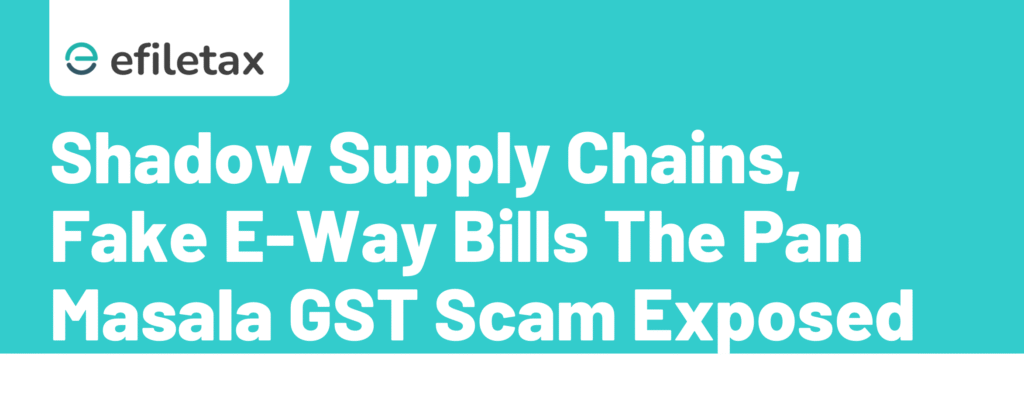
Shadow Supply Chain & Missing E-Way Bills: GST Evasion Case Explained
A major GST evasion case involving a pan masala manufacturer has once again highlighted how missing e-way bills and unaccounted movement of goods can fuel tax fraud. This blog breaks down how the shadow supply chain operated, what GST laws were violated, and how authorities detected it.
Let’s decode the case, based on official findings, and what it means for other businesses in high-risk sectors like tobacco, gutkha, and FMCG.
What Is a Shadow Supply Chain?
A shadow supply chain refers to the unauthorized movement of goods that bypasses official documentation—especially e-way bills under GST.
In this case, goods were:
- Moved without e-way bills
- Sold through cash transactions
- Not reported in GST returns
- Stored in undisclosed godowns
These practices violated Rule 138 of CGST Rules and Section 122 of CGST Act (penalty for fraud).
The Pan Masala Manufacturer Case: Key Details
As per DGGI investigations (2024–25):
| Particulars | Details |
|---|---|
| Industry involved | Pan Masala, Tobacco (gutkha) |
| Location | Kanpur, Uttar Pradesh |
| Method of Evasion | Missing e-way bills, fake invoices |
| Unaccounted production | Estimated ₹400+ crore |
| Tax evasion uncovered | Over ₹100 crore (incl. cess) |
| Action taken | Raids, asset seizures, prosecution |
📌 Source: Press release by CBIC & DGGI – March 2025
GST Legal Provisions Violated
Section 122: Penalty for supply without invoices or e-way bills
Rule 138: Mandatory generation of e-way bill for inter/intrastate supply
Section 67: Power to inspect, search, seize goods
Section 132: Prosecution for deliberate evasion (>₹5 crore = non-bailable offence)
This case triggered all the above provisions, leading to criminal charges and GST recovery proceedings.
Why Pan Masala and Gutkha Are on DGGI Radar
- High tax burden due to Compensation Cess
- Easy under-reporting due to small packaging
- Mostly cash transactions, hard to trace
- Multiple distribution layers and agents
CBIC had earlier issued Circular No. 49/23/2018-GST flagging risks in tobacco and pan masala trade.
Expert Tip: How to Stay Compliant
Businesses in high-risk sectors must:
- Use real-time e-invoice and e-way bill systems
- Maintain stock registers and production logs
- Link production with electricity consumption (DGGI tracks this)
- Avoid storage in unauthorized locations
🔗 You can also read our blog on Top GST Audit Triggers for 2025
How the Fraud Was Caught
The DGGI used:
- Electricity usage mismatch with declared output
- Intelligence on cash sales and duplicate packaging
- RFID-based movement tracking and surveillance
- Parallel invoice trails and shell distributors
This matches with past cases where undisclosed manufacturing units were found in rural and semi-urban areas.
Practical Takeaways for Businesses
- E-way bill non-compliance = red flag
- Cash-based trade is under tight scrutiny
- Input tax credit (ITC) may be denied if linked to fraud
- Prosecution risks are real in high-value frauds
For MSMEs in similar industries: regular GST internal audits and GSTR-9C reconciliation are a must.
FAQs: Shadow Supply Chains & GST
Q1: What is the penalty for missing e-way bills?
A: ₹10,000 or the tax sought to be evaded—whichever is higher (Section 122, CGST Act).
Q2: Can ITC be claimed if the supplier is a fraud?
A: No. As per Section 16(2) and recent SC rulings, ITC can be denied if the supplier is bogus.
Q3: Are such offences bailable?
A: No, if tax evaded is over ₹5 crore, as per Section 132, it’s a non-bailable offence.
Conclusion: Compliance Is the Only Safe Route
This case is a reminder that GST enforcement is tightening, especially for industries prone to evasion. Businesses must embrace digital compliance tools, maintain clean documentation, and avoid any shortcuts involving unbilled transactions or unregistered godowns.